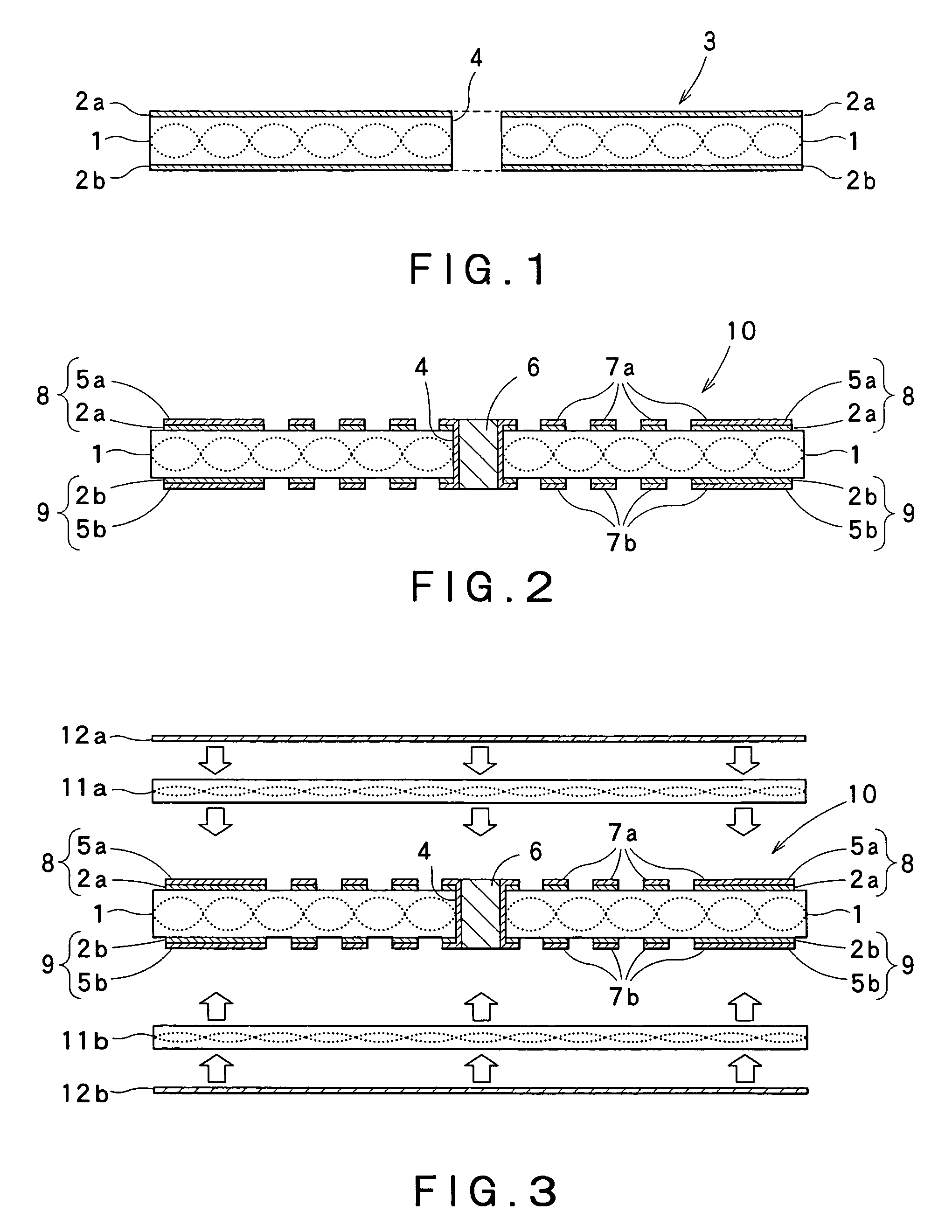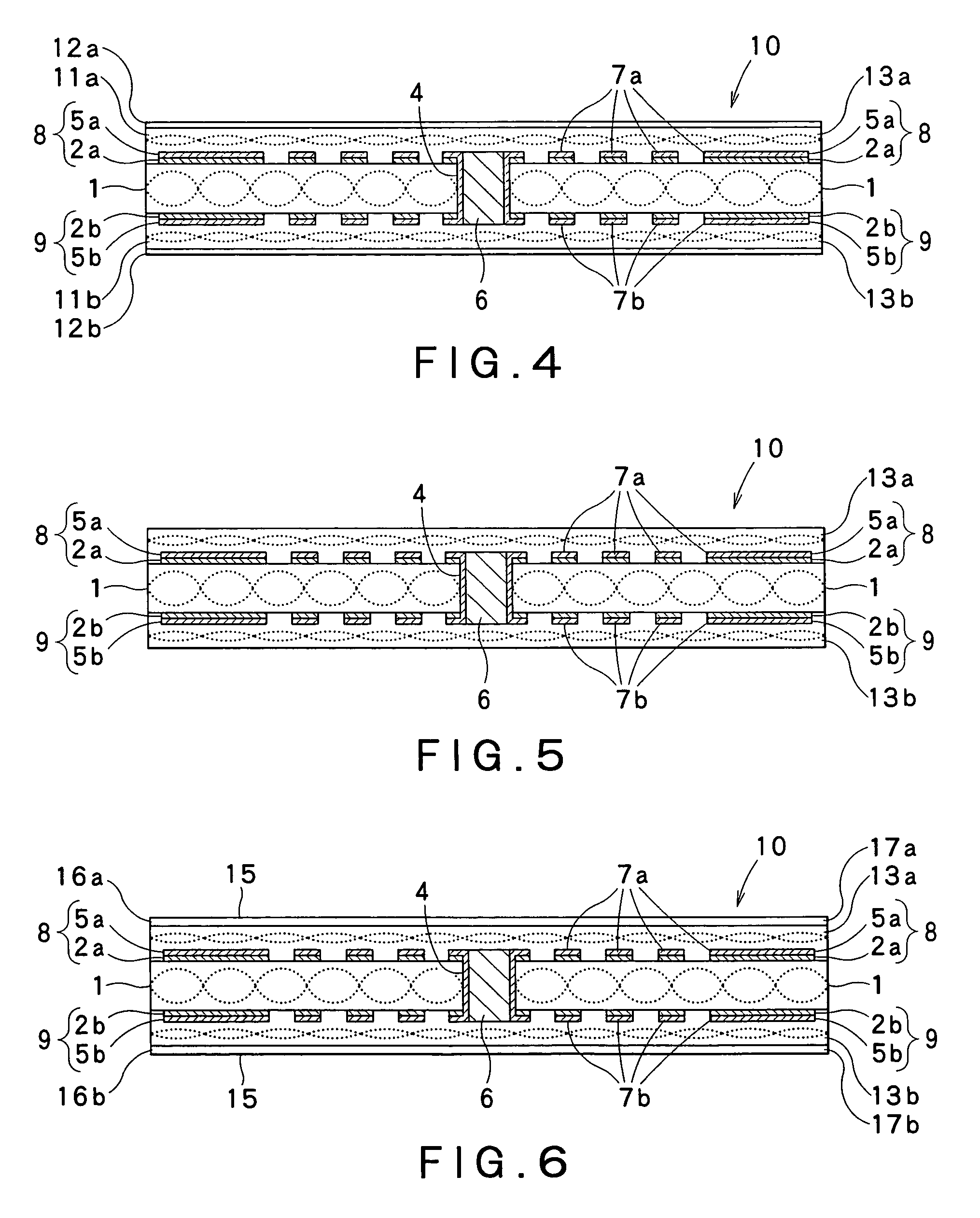Printed wiring board
a printed wiring and wire technology, applied in the direction of printed circuit details, printed circuit structure associations, electrical connection printed elements, etc., can solve the problems of reducing the reliability of via holes on connectability, difficulty in forming finer wiring patterns on thicker conductive layers, and thin printed wiring boards with lower stiffness. , to achieve the effect of sufficient adhesiveness and high stiffness
- Summary
- Abstract
- Description
- Claims
- Application Information
AI Technical Summary
Benefits of technology
Problems solved by technology
Method used
Image
Examples
first embodiment
[0051]Disclosed first with reference to FIGS. 1 to 10 is a first embodiment of a method of producing a printed wiring board, according to the present invention, employing subtractive etching. An exemplary printed wiring board to be produced in the first embodiment is a four-layer printed wiring board.
[0052]A feature of the first embodiment is to provide insulating layers with a dual-layer construction that consists of a first insulating layer formed by curing a B-staged insulative sheet made of a high-stiff sheet-type reinforcing material containing resin and a second insulating layer formed by curing resin ink containing particles or components soluble to an agent such as an oxidant or an acid, or a first insulating layer for higher stiffness and a second insulating layer for higher adhesiveness.
[0053](Processing Step A1)
[0054]A processing step A1 is described with reference to FIG. 1.
[0055]Prepared first is a double-sided copper-coated board 3. The board 3 is made of a core substr...
second embodiment
[0110]Disclosed next with reference to FIGS. 8 and 11 to 16 is a second embodiment of a method of producing a printed wiring board, according to the present invention, employing semi-additive processing. An exemplary printed wiring board to be produced in the second embodiment is also a four-layer printed wiring board.
[0111]Different from the first embodiment employing subtractive etching, the second embodiment employs semi-additive processing. In general, semi-additive processing requires a higher number of processing steps than subtractive etching, however, more advantageous on achieving finer and denser wiring patterns.
[0112]The second embodiment is identical to the first embodiment, except for a wiring pattern forming process. The elements in the second embodiment that are the same as or analogous to those in the first embodiment are given the same reference numerals as those in the first embodiment, and not described in detail or the description thereof is omitted.
[0113](Proces...
third embodiment
[0135]Disclosed next with reference to FIGS. 17 to 23 is a third embodiment of a method of producing a printed wiring board, according to the present invention, employing subtractive etching, that gives further advantages to the first and second embodiments.
[0136]In detail, the third embodiment achieves finer and denser wiring patterns not only on the third and fourth wiring layers 23 and 24 (the first embodiment) or the third and fourth wiring layers 59 and 60 (the second embodiment), but also the first and second wiring layers 8 and 9, in a four-layer printed wiring board.
[0137]The elements in third embodiment that are the same as or analogous to those in the first embodiment are given the same reference numerals as those in the first embodiment, and not described in detail or the description thereof is omitted.
[0138](Processing Step C1)
[0139]A processing step C1 is described with reference to FIGS. 17 and 18.
[0140]Prepared first is a double-sided copper-coated board 3 identical t...
PUM
 Login to View More
Login to View More Abstract
Description
Claims
Application Information
 Login to View More
Login to View More - R&D
- Intellectual Property
- Life Sciences
- Materials
- Tech Scout
- Unparalleled Data Quality
- Higher Quality Content
- 60% Fewer Hallucinations
Browse by: Latest US Patents, China's latest patents, Technical Efficacy Thesaurus, Application Domain, Technology Topic, Popular Technical Reports.
© 2025 PatSnap. All rights reserved.Legal|Privacy policy|Modern Slavery Act Transparency Statement|Sitemap|About US| Contact US: help@patsnap.com



